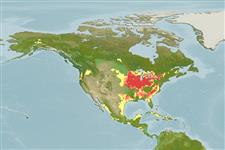Classification / Names
Common names from other countries
Référence principale
Taille / Poids / Âge
Max length : 53.0 cm TL mâle / non sexé; (Ref. 5723); common length : 25.0 cm TL mâle / non sexé; (Ref. 12193); poids max. publié: 2.4 kg (Ref. 4699); âge max. reporté: 10 années (Ref. 12193)
Environnement
; eau douce démersal
Climat / Gamme
Temperate; ? - 31°C (Ref. 12741), preferred ?; 40°N - 35°N
Distribution
North America: Great Lakes, Hudson Bay and Mississippi River basins from New York, USA and from Ontario, Canada west to Minnesota and South Dakota and south to the Gulf of Mexico in the USA; Gulf drainages from Mobile Bay in Georgia and Alabama to Nueces River in Texas, USA.
Pays | Zones FAO | Écosystèmes | Occurrences | Introductions
Statut dans la liste rouge de l'IUCN (Ref. 115185)
Menace pour l'homme
Harmless
Utilisations par l'homme
Pêche sportive: oui
Plus d'informations
RéférencesAquacultureProfil d'aquacultureSouchesGénétiqueFréquences alléliquesHéritabilitéPathologiesTraitementMass conversion
CollaborateursImagesStamps, CoinsSonsCiguateraVitesseType de nageSurface branchialeOtolithesCerveauxVision
Outils
Articles particuliers
Télécharger en XML
Sources Internet
Estimates of some properties based on models
Phylogenetic diversity index
PD50 = 0.7500 many relatives (e.g. carps) 0.5 - 2.0 few relatives (e.g. lungfishes)
Niveau trophique
4.4 ±0.6 se; Based on diet studies.
Résilience
Milieu, temps minimum de doublement de population : 1,4 à 4,4 années (Assuming tm=2-4; Fec up to 140,000)
Vulnérabilité
Low to moderate vulnerability (29 of 100)
Catégorie de prix
